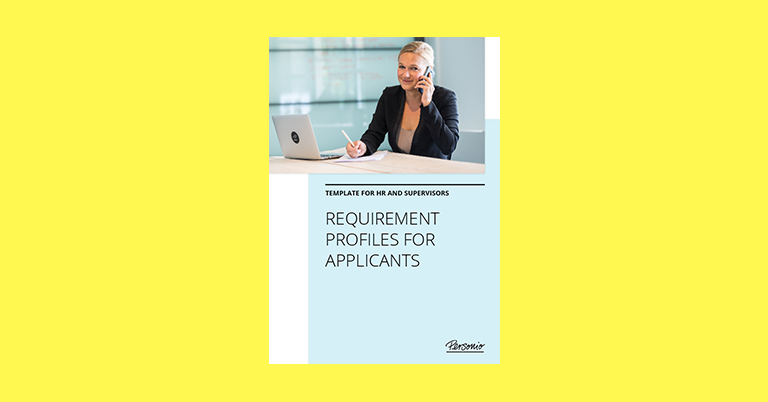The 5 Steps to Job Analysis Success

With so many moving parts, your company needs to run like a well-oiled machine. But that means having a thorough understanding of each component, or what we might consider each and every job.
By performing a proper job analysis, you can not only create a comprehensive description of a position but also use that information to inform your organizational structure, streamline your hiring process, and much more.
Let’s talk about hiring with Personio. Learn more today.What Is A Job Analysis?
A job analysis is a dissection of a role within your company. When performing a job analysis, you look at the responsibilities included in the job, the qualifications required to do the job well, how it relates to other positions within your organization, and when/how it’s performed.
Keep in mind: You’re not analysing a worker’s performance in a specific position, but the actual position itself. However, you may want to interview or survey workers who hold or have held the position to gain a more in-depth understanding of the role in practice.
Is A Job Analysis The Same As A Job Evaluation?
Somewhat, but mostly no. A job evaluation compares roles within an organization to establish pay rates. While this may relate to a job analysis, the analysis itself is in more of a quantitative sense. It can inform an evaluation, but is not limited to it.
The 5 Benefits Of Performing A Job Analysis
Whether you’re a company of dozens or thousands, you’ll benefit from performing a job analysis for each role within your organization. In the end, you’ll better understand what the role entails and can use what you’ve learned to improve your business across the board.
Here are five of the top benefits of performing a job analysis:
Outlines Requirements And Pay Grade
After you complete a job analysis, you can determine if the role is entry-level, intermediate, or senior, depending on the complexity of the work, skills, knowledge, and experience needed to do it successfully. This will then inform the pay grade for the role and give you data to support your selection.
Streamlines Applicant Selection And Recruitment
When you better understand a job, you can better position the job ad and attract higher-quality candidates. After completing a job analysis, you’ll gain more insight into the responsibilities and requirements of the role and what behavioural and personality traits you need in the worker. All of this can help you find a candidate that’s perfectly aligned with your company.
Creates More Effective Training And Development Programs
By determining the exact skills and knowledge needed for a role, you can develop more effective training and development programs that specifically cater to them. With this information, you can ensure new hires get the training and support they need to onboard smoothly and build out learning and development solutions that promote long-term growth.
Helps Organizational Design And Planning
With a job analysis, you can determine where a job fits within a department and the company, as well as who the employee reports to and interacts with on a daily basis.
These analyses also help with succession planning and organizational design. With the information you gather from your analysis, you can map out a job path that shows how an employee progresses to the role and what positions they can advance to afterward.
These analyses can also bring to light any overlapping responsibilities with another role, which can help you consolidate positions and departments.
Here’s our complete guide to succession planning for organizations.
Provides Clarity On Legalities, Safety, And Compliance
When workers have clear and detailed job descriptions to follow, they can perform their duties with confidence—and ideally, with fewer incidents. You can lay out distinct boundaries, work conditions, and the machinery/tools used in the role, along with the training/certifications required to use them safely.
Discover Personio: Top Talent At Your Doorstep
Hire top talent to help your organization grow and achieve new heights, Personio’s ATS can help. Click the button below to learn more about hiring with Personio.
How It WorksHow Do You Perform A Job Analysis?
What’s the best approach to completing a job analysis? You can take a few different routes depending on your goals, the role itself, the company size, and the data you want to gather.
Tool | How It Works |
|---|---|
Open-Ended Questionnaire | With an open-ended questionnaire, you allow workers and managers to share their insights into a job while providing some guidance along the way. You can deliver the questionnaire in digital or paper form, and once you gather the answers, create a job description that fits the role perfectly. |
Structured Questionnaire | With a structured questionnaire, you can provide the worker and their manager with multiple-choice questions to get more specific information on a job and receive more objective answers. For example, how many hours are worked per week, how often a task is performed, their years of experience, etc. |
Observation | If you want a first-hand understanding of a job, observation may be your best bet. Through observation, you shadow a worker and gain a realistic look into their day-to-day tasks, activities, obstacles, and successes. It's best to observe an employee over a few days so you can gather a broad range of data. |
Diary Or Log | In lieu of observation, employees can keep a work diary or log of what they do during the workday for a predetermined amount of time. However, this information can be difficult for HR professionals to analyse if they don't get enough context around the diary entries. It can also be an overwhelming amount of data to comb through. |
Interviews | By conducting one-on-one or group interviews with workers and managers, you can gather information on the role and its department and use follow-up questionnaires to fill in any knowledge gaps. If you're performing a job analysis on a new position, talk with the manager and team that the role will be added to. |
HR Software: One Place For All Your People Processes
Could you use a bird’s eye view to keep track of all your people processes? From recruiting to performance, reporting to document templates, Personio can be your single source of truth. Learn a bit more about it today.
Have A Look NowThe Step-By-Step Job Analysis Process
Performing a job analysis is no small undertaking. It starts with getting real-time insight into a position and ends with a more coherent and aligned company:
1. Gather Data
First, you need to take the time to understand the ins and outs of the role. Depending on which information-gathering approach you want to take, book your meetings or build your surveys to send out to current and former workers who held or hold that position, as well as the managers involved.
Here are a few questions and topics you should uncover in your fact-finding mission:
What are the skills, knowledge, and expertise required to perform the job well?
Is it an entry-level, intermediate, senior position?
How are workers within this role considered for promotion?
What’s included in the onboarding and training process?
How can an employee in this job advance in the company?
What training programs can someone in this role benefit from?
How is an employee’s performance measured?
What machinery and equipment are used in the role?
What skills or certifications are required to perform this role correctly and safely?
What are the working conditions for someone in this role? How does that impact the employee?
Who else does an employee in this role interact with?
How and by whom will they be supervised?
How does this role impact the company’s finances and budgeting?
2. Review Inefficiencies
Most jobs aren’t analysed frequently enough to keep up with technological advancements, changing responsibilities, and team developments. Review the current job description with a worker or manager to determine how the role has changed:
Do they no longer complete certain tasks?
Have they taken on new tasks and responsibilities?
Have the programs or tools they use changed?
Are there skill gaps that need to be addressed?
How can the workload, processes, or employee experience be improved?
3. Research Industry Standards
Similar roles can be found across companies and industries, and while yours will be unique, you can always learn a little something from the other guys.
Review multiple job descriptions similar to the one you’re analysing to see what other companies include and how you can improve upon it to attract talent.
TIP: Search on Google, LinkedIn, Glassdoor, recruiting websites, and competitors’ careers pages to compile multiple sources.
4. Draft The Description
Based on the information you’ve gathered, you should now be able to draft the ideal job description. Here’s what it should cover:
What To Include | Why It Matters |
|---|---|
Outcomes | Outline the expectations you have for the worker who takes on this role. This can be set goals and objectives within a time period or how the role fits into the company's overall mission. |
Skills, Training, And Competencies | What tasks, responsibilities, tools, programs, or industries should someone in this role have experience in? Are there a certain number of years of experience that would give them the expertise desired? |
Behavioural And Cultural Alignment | The best candidate should possess the right set of skills for the job, but they should also share similar values with your company and have a personality type that aligns with the role. Do they need to be autonomous or a natural leader? Should they be data-oriented, or are you looking for someone with a creative spirit? |
Salary Bands | If your company boasts a transparent and accountable workplace culture, you should openly share salary bands and pay expectations. To set a salary band, consider the skills and training required for the role, the responsibilities involved, your competitors' salaries, and your company's established salary brackets for other comparable roles. |
5. Formalization
Once you’ve completed your job analysis and corresponding description, review them with a worker and manager familiar with the role. After approval, formalize the documents according to your company’s established processes and make the information easily accessible for those that need it.
Streamline your employee development

Define performance cycles, set goals, give effective feedback and evaluate performance fairly. Put structure on how you grow and retain staff with powerful performance management.
Boost your performanceBefore You Go: Job Analysis Best Practices To Keep In Mind
Now you’re ready to perform your next job analysis—well, almost. Before you dive in, let’s take a look at some of the best practices to abide by:
Stay On Mission
Whether you’re updating an established job description or creating a new one, ensure that the role and responsibilities align with your company’s mission, values, and goals.
Be Clear
Make the job description clear and easy to understand by anyone who reads it, whether they’re a prospective candidate, a new recruit, an immediate team member, or an employee from an unrelated department.
Be Open
Company roles are constantly changing and evolving with the business. Review job descriptions on an annual basis to see what can be improved, if the tasks and responsibilities are still relevant, and if the pay is still consummate with the role.
Share Widely
Share your findings and descriptions with employees. Be open to questions or clarifications so everyone has a solid understanding of the role and responsibility of the job, as well as how it impacts them and their work.


